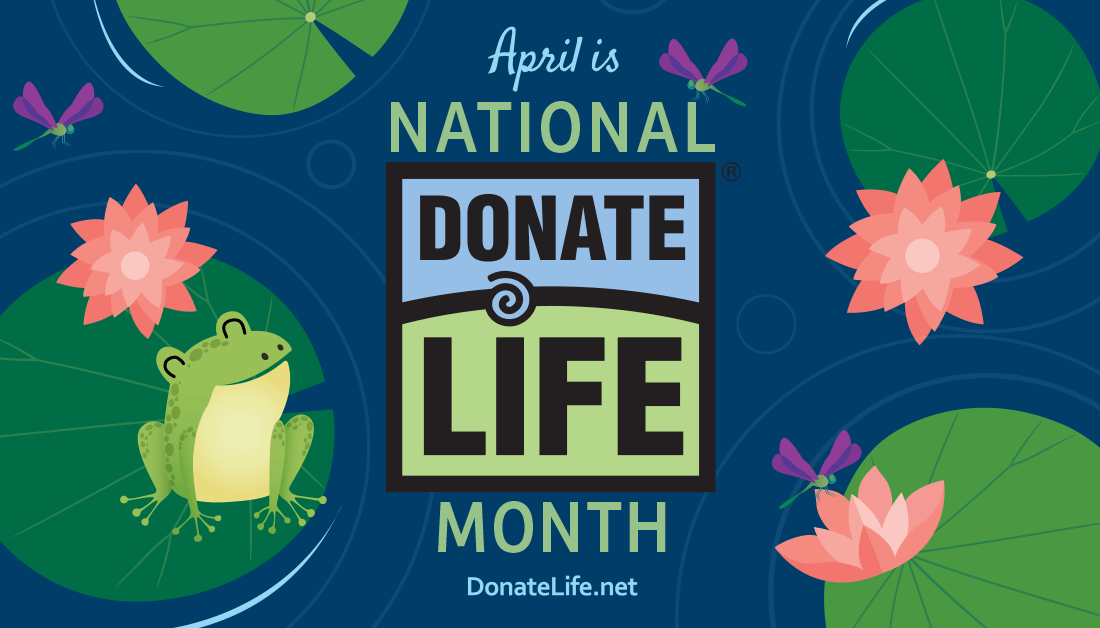Week 10: National Donate Life Month

This week starts April which is now my favorite month of the whole year. Even despite the unpredictable weather and school slump many students face at this point in the school year.
What makes April your favorite month? Does it really matter? The short answer is... YES.
April means National Donate Life Month. What is National Donate Life Month?
National Donate Life Month aims to spread awareness of organ, eye, and tissue donation and to honor those who have donated. This national month has been celebrated every year since 2003.
What makes organ donation such a big deal to me is that nearly three years ago I received a new lifesaving liver. I will get more into that for next week's blog post.
What is Donate Life? What do they do?
Anyone can become an organ donor, no matter your age. Your medical condition at the time of death will determine what organs and tissue can be donated. If you would like to declare your choice to be an organ donor, be sure to enroll in your state’s donor registry and share your decision with your family and friends. Your decision to donate life can help to save many lives.
- Learn the facts about organ donation.
- Learn more about deceased donation or living donation.
If you have a medical condition that may cause one or more of your vital organs to fail, a transplant may be a treatment option. A transplant is a surgical operation to give a functioning human organ to someone whose organ has stopped working or is close to failing. In some cases, a living person can donate all or part of a functioning organ. In other instances, the donor would be someone who has recently passed away.
The organs that can be transplanted are:
- Liver
- Kidney
- Pancreas
- Kidney-pancreas (can be transplanted at the same time)
- Heart
- Lung
- Heart-lung (can be transplanted at the same time)
- Intestine
- Vascularized composite allografts, or VCAs, such as the face, hand, or uterus transplantation
The matching process contains five steps:
- An organ is donated. When the organ becomes available, the OPO representative managing the donor reports medical and genetic information, including organ size, and condition, blood type and tissue type to UNOS.
- UNOS generates a list of potential recipients. UNetSM, UNOS’ centralized computer network that links all organ procurement organizations, transplant hospitals and histocompatibility labs, generates a list of potential transplant candidates who have medical and biologic profiles compatible with the donor. The system ranks candidates by this biological information, as well as clinical characteristics and time spent on the waiting list.
- The transplant hospital is notified of an available organ. Organ placement specialists at the OPO or the UNOS Organ Center contact the programs whose patients appear on the local list.
- The transplant team considers the organ for the patient. When the team is offered an organ, it bases its acceptance or refusal of the organ upon established medical criteria, organ condition, candidate condition, staff and patient availability, and organ transportation. By policy, the transplant team has only one hour to make its decision.
- The organ is accepted or declined. If the organ is not accepted, the OPO continues to offer it for patients at other hospitals until it is placed.
- To understand how patients are matched on the national waiting list, it’s helpful to think of the list as a “pool” of patients. Each time an organ becomes available, UNetSM searches the entire “pool” for the patients who are a match for the organ. A new list is made from those who match.
The patients on this new list are ranked in order of their level of match to that donor organ. The organ is offered to the transplant hospital where the first patient is listed. Other factors that may be considered are the patient’s current medical status, geographical location, and time on the list. If the organ is refused for any reason, the transplant hospital of the next patient on the list is contacted. This process continues until a match is made.

Wow! Thank you so much for educating me on this very important month! I've never known much about the specifics of organ donation so this was very interesting to learn more about this process. I can't wait to hear more about your personal experience. Thanks for sharing this with me!
ReplyDeleteI had no knowledge that April held such an important meaning. Thank you for educating me on the specifications of organ donation! Very inspiring to see you encouraging others to educate themselves on what organ donation is.
ReplyDelete